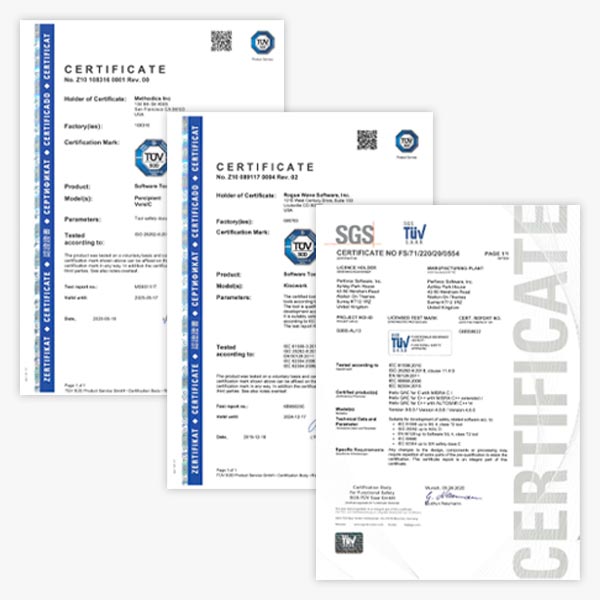Strict Functional Safety Requirements
Specific requirements vary by functional safety standard. Critical standards include:
- IEC 61508 is the general functional safety standard.
- ISO 26262 for automotive.
- DO-254 and DO-178C for aerospace and defense.
- ISO 60601 and IEC 62304 for medical devices.
In order to satisfy functional safety requirements, you need to be able to demonstrate and document compliance. This is very challenging — especially if you don’t have the right tools.
Key Solutions For Functional Safety
Perforce offers the following solutions to aid in functional safety compliance.
Automatically ensures functional safety and MISRA compliance with FuSa certification by TÜV-SÜD.
Automatically traces requirements, tests, and defects for easier functional safety compliance.
Automatically provides traceability and generates documentation for FuSa compliance.
Seamlessly integrates with Helix ALM and Helix IPLM for end-to-end traceability of assets.
How Perforce Functional Safety Solutions Accelerate Velocity
Perforce functional safety solutions help you demonstrate and document compliance, so you can accelerate velocity.
Coding Standards Compliance
Ensuring that code is safe, secure, and reliable can be a difficult and time-consuming task, as specific coding and design guidelines must be met. However, by applying a coding standard, it makes it easier to verify the functional safety and reliability of the code. A static analyzer — like Helix QAC — is the most efficient and effective way to ensure that code is compliant.
Helix QAC check code against a coding standard — like MISRA or AUTOSAR— to help ensure compliance. In addition, Helix QAC’s automated analysis identifies vulnerabilities and errors as code is being written — this helps to identify and eliminate defects earlier in development. What’s more, Helix QAC is certified for functional safety compliance by TÜV-SÜD.
Related Resource: Apply Coding Standards to Ensure Your Software Is Functionally Safe


Requirements Traceability
Traceability has tremendous value for companies operating in any industry, but it is critical for those in regulated industries. It links artifacts — requirements, source code, tests, and issues — across the development lifecycle. Traceability guidelines are included in a number of regulations to help verify product quality and safety.
Helix ALM is a powerful, modern application lifecycle management solution that simplifies end-to-end traceability. It automatically builds relationships between requirements, tests, and issues to provide upstream and downstream traceability of development artifacts. This helps teams meet quality standards, produce safe products, and stay competitive.
Organizations in the embedded systems industry need traceability to ensure safety and prove compliance. Helix ALM makes this easy and efficient — using any methodology, at any scale.
Related Resource: 5 Essential Traceability Components For Medical Device Development
Verification Traceability
Functional safety standards also include requirements for verification traceability for semiconductor and embedded system designs through evidence documentation. You must be able to document every step you take toward developing a complete component or subsystem — and trace it back to the original specification.
Helix IPLM (formerly Methodics IPLM) is at the heart of providing the traceability need for functional safety compliance. The platform has built-in traceability for hardware and software IP. And Helix IPLM extends traceability into other engineering systems and their data.
Helix Core, for instance, is fully integrated with Helix IPLM. The Helix IPLM platform can also integrate with requirements management and defect tracking tools like Helix ALM via API. Plus, it integrates with continuous integration solutions and EDA verification platforms.
As a result, Helix IPLM provides traceability from requirements through design to verification and validation.
All relevant information from all connected systems can be linked or stored as meta information associated with all design IP. You’ll get a single source to access all the information needed for evidence documentation. Plus, this information can be used to automatically generate all documentation needed for a compliant functional safety solution.

